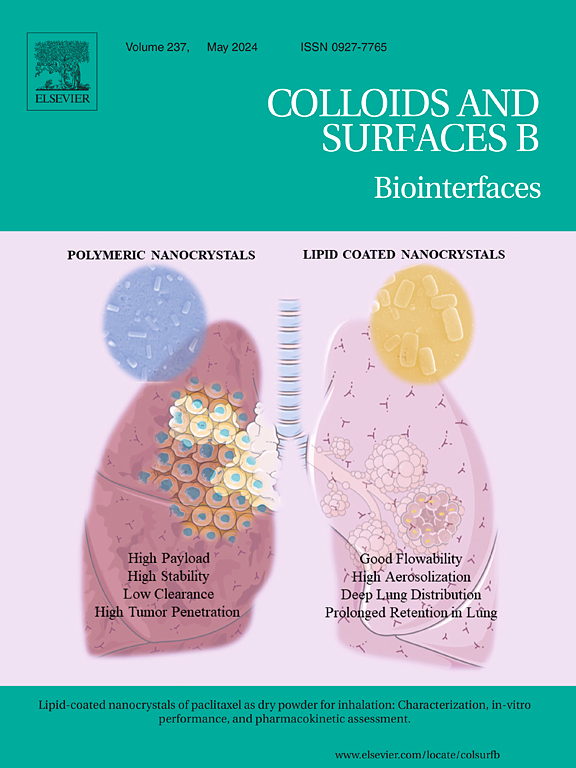Tannic acid-based bio-MOFs with antibacterial and antioxidant properties acquiring non-hemolytic and non-cytotoxic characteristics
IF 5.4
2区 医学
Q1 BIOPHYSICS
引用次数: 0
Abstract
Tannic acid (TA) based bio-metal phenolic networks (bio-MPNs) were prepared by using Cu(II), Zn(II), Bi(III), Ce(III), La(III), and Ti(IV) metal ions. TA-based bio-MPNs exhibited wedge-shaped pores between 16.4 and 25.8 nm pore size ranges. The higher gravimetric yield% was achieved for TA-Bi(III), and TA-Ti(IV) bio-MPNs with more than 90 %, and higher surface area was observed for TA-La(IIII) bio-MPNs as 56.2 m2/g with 17.3 nm average pore sizes. All TA-based MPNs are non-hemolytic with less than 5 % hemolysis ratio, whereas TA-based Bio-MPNs do not affect blood clotting with > 90 % blood clotting indexes except for TA-Cu(II) Bio-MPNs at 0.1 mg/mL concentration. Moreover, TA-Bi(III) and TA-Ce(III) Bio-MPNs were found to be safer materials showing no significant toxicity on L929 fibroblast cells at 100 μg/mL concentration, along with TA-based Bio-MPNs prepared with Cu(II), Zn(II), La(III), and Ti(IV) metal ions that could be safely used in in vivo applications at 1 μg/mL concentration. It has been proven by 2 different antioxidant tests that the prepared TA-based Bio-MPNs show antioxidant properties even if their TA-derived antioxidant properties decrease. Furthermore, all types of TA-based Bio-MPNs show great antimicrobial activity depending on the metal ion or microorganism types and the highest antibacterial/antifungal effect was determined for TA-Cu(II), and TA-Zn(II) Bio-MPNs with the lowest MBC/MFC values against Pseudomonas aeruginosa ATCC 10145, Bacillus subtilis ATCC 6633, and Candida albicans ATCC 10231.
单宁酸基生物mofs具有抗菌和抗氧化特性,具有非溶血和非细胞毒性特性
采用Cu(II)、Zn(II)、Bi(III)、Ce(III)、La(III)、Ti(IV)等金属离子制备了单宁酸(TA)基生物金属酚网络(bio-MPNs)。ta基生物mpn具有16.4 ~ 25.8 nm的楔形孔。TA-Bi(III)和TA-Ti(IV)生物mpns的重量产率均大于90 %,TA-La(IIII)生物mpns的比表面积为56.2 m2/g,平均孔径为17.3 nm。所有ta基MPNs均为非溶血性,溶血率小于5 %,而ta基Bio-MPNs除0.1 mg/mL浓度的TA-Cu(II) Bio-MPNs外,不影响凝血指标为>; 90 %的凝血指标。此外,TA-Bi(III)和TA-Ce(III) bio - mpn在100 μg/mL浓度下对L929成纤维细胞没有明显毒性,而以Cu(II)、Zn(II)、La(III)和Ti(IV)金属离子制备的ta基bio - mpn在1 μg/mL浓度下可以安全用于体内应用。通过两种不同的抗氧化试验证明,制备的ta基bio - mpn具有抗氧化性能,即使ta衍生的抗氧化性能降低。此外,根据金属离子或微生物类型的不同,所有类型的ta基Bio-MPNs均表现出良好的抗菌活性,其中TA-Cu(II)和TA-Zn(II) Bio-MPNs对铜绿假单胞菌ATCC 10145、枯草芽孢杆菌ATCC 6633和白色念珠菌ATCC 10231的抗菌/抗真菌效果最高,MBC/MFC值最低。
本文章由计算机程序翻译,如有差异,请以英文原文为准。
求助全文
约1分钟内获得全文
求助全文
来源期刊

Colloids and Surfaces B: Biointerfaces
生物-材料科学:生物材料
CiteScore
11.10
自引率
3.40%
发文量
730
审稿时长
42 days
期刊介绍:
Colloids and Surfaces B: Biointerfaces is an international journal devoted to fundamental and applied research on colloid and interfacial phenomena in relation to systems of biological origin, having particular relevance to the medical, pharmaceutical, biotechnological, food and cosmetic fields.
Submissions that: (1) deal solely with biological phenomena and do not describe the physico-chemical or colloid-chemical background and/or mechanism of the phenomena, and (2) deal solely with colloid/interfacial phenomena and do not have appropriate biological content or relevance, are outside the scope of the journal and will not be considered for publication.
The journal publishes regular research papers, reviews, short communications and invited perspective articles, called BioInterface Perspectives. The BioInterface Perspective provide researchers the opportunity to review their own work, as well as provide insight into the work of others that inspired and influenced the author. Regular articles should have a maximum total length of 6,000 words. In addition, a (combined) maximum of 8 normal-sized figures and/or tables is allowed (so for instance 3 tables and 5 figures). For multiple-panel figures each set of two panels equates to one figure. Short communications should not exceed half of the above. It is required to give on the article cover page a short statistical summary of the article listing the total number of words and tables/figures.
 求助内容:
求助内容: 应助结果提醒方式:
应助结果提醒方式:


